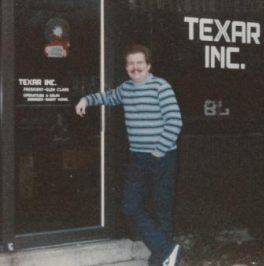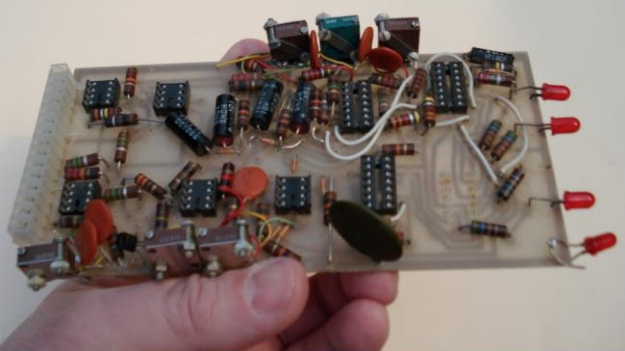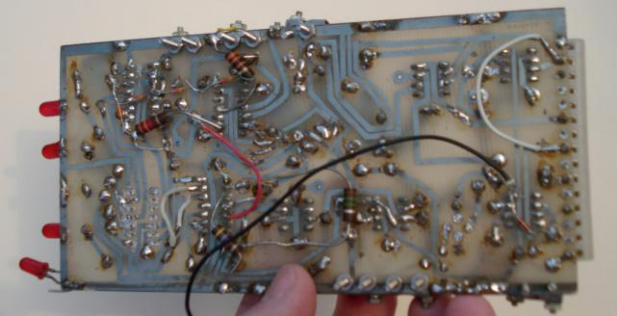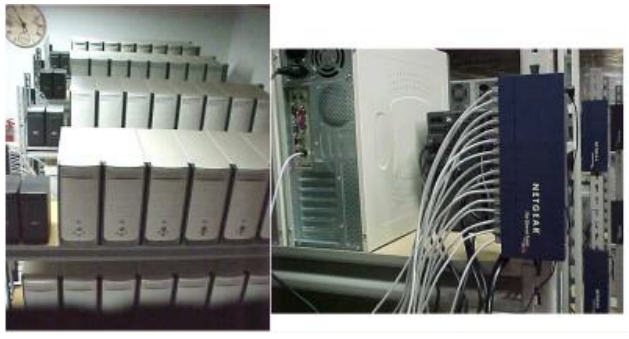The Audio Prism Story

[June 2011] In the history of audio processing, the TEXAR Audio Prism holds its own place as one of the key tools in the arsenals of stations fighting to produce their “signature” sound and stand out in their market. We asked Glen Clark to recall the days when he designed and built the Audio Prism, and how it became a “broadcast standard.”
The Audio Prism was a design born of desperation.
Rocking Hard in 1979
It was 1979 and the Optimod 8100 was still in the future. The coin of the realm at the time for a major-market rock station was a pair of Dorrough DAP-310s in front of an Optimod 8000.
I was working at the oldies FM station in Pittsburgh owned by the Pittsburgh Post Gazette. The call at the time was WPEZ. Today, it is known as 3WS. Our arch rival was the Hearst Broadcasting FM station across the street, WXKX, also known as 96-Kicks.
It was a knock-down, drag-out fight. Our Program Director (PD) was the very able Big Jim Edwards (a.k.a. James K. Davis) of CKLW and WLS-FM fame. Their PD was the equally capable Bobby Christian who had come from Phoenix and would later go to Minneapolis. We both did anything and everything possible to gain even the slightest advantage both in programming and technically.
The Loudness War Erupts
One morning, our air staff got in their cars to go to work and noticed we were getting hammered in the loudness war by 96-Kicks. After a brief staff meeting to talk about the new balance of power, we came to the conclusion that the competition must simply have set their FM deviation to an illegal level, perhaps by accident.
Jim Davis and I went into the master control room and dialed around the FM band, expecting to confirm that 96-Kicks was over-modulating. Much to our surprise, we found that 96-Kicks was completely legal. Their average modulation was clearly higher than anyone else on the dial. But their peaks were under 100%.
Good news and bad news followed. The good news was that it did not take long to figure out what 96-Kicks’ new secret weapon was. A chatty weekend disk jockey who worked at both stations and who was hoping to land a full-time 2 gig with WPEZ in return for some information was happy to tell us that 96-Kicks had just installed the then-new CRL System-4 for FM.
We had never even heard of CRL. Neither had many other people at that time. They just appeared suddenly, like a meteor in the night sky.
That was the good news.
Forced to Take Another Route
The bad news was that we could not get one for ourselves.
Bobby Christian, the Program Director for 96- Kicks was friends with the President of CRL. They had worked together in Phoenix. And for some reason, CRL just never seemed to be able to find an FM System-4 to send to WPEZ.
WPEZ’s DAP-310 and Optimod 8000 combination were light years ahead of what they replaced. But there was no combination of settings for the WPEZ air chain that was going to catch up with the CRL System-4. The System-4 was more advanced technology and it was going to take new technology to equal it.
The only solution was for us to develop that new technology in-house. The deadline we set for ourselves was the day before the next Arbitron ratings period started. We had just two months. Since there was no other processor on the commercial market that could beat the CRL system, the ball was in my court. So, I headed for the laboratory.
Processing Ninja Background
Fortunately, I had been thinking about processing, developing my own ideas and concepts for quite a while, especially since my days as Chief Engineer of WLS-FM in Chicago (1972-74) where I was responsible for the audio processing on both the FM and WLS (AM).
I know that today, people stick the latest digital box in the rack, play with the presents for three days, and then forget about it. In 1972, it was a completely different world.
If you were in a market ranked higher than #10, you were “rolling your own.” There was too much at stake to just go with out-of-the-box hardware. If you were a major market CE, you had to be a processing ninja.
Going Against Strong Competition
WLS (AM)’s arch rival at the time was WCFL (AM). Unfortunately they were not just any pushover. Their sharp engineer, Jim Loupas, had a much better transmitter plant than we did – and to top it off they were located much closer to downtown than we were, putting over three times the RF in downtown Chicago, 50 mV/m from WCFL to our 15 mV/m from WLS.
The WCFL transmitter was the Continental 317C, which had great fidelity and modulated well over 100% on positive peaks. Our GE was reliable, but did not sound as bright nor would it go past 100% So, as you can imagine, doing processing battle with WCFL was pretty much a full time job in itself.
The point is that if you were the CE of a rock station in a Top-5 market in 1972, you were not putting factory stock processing on the air any more than NASCAR race teams run factory stock Chevy Malibus at the Daytona 500. You were constantly thinking about how to modify, enhance, and augment the current processing state-of-the-art.
There was no course you could take back then, nor any one book that you could read, to learn the craft. It was a matter of knowing the music and exploring the interactions from each processing adjustment – and what the impact would be on the high frequency clipper seven stages further downstream. You had to feel it in your bones.
Building a Better Mousetrap
Having such a background, I was able to go back to the lab and, just in time two months later, unveil the first Audio Prisms, on the air, at 2:00 PM on the day before the next Arbitron started.
In 1979, the secret to increased loudness was to make the attack and recovery time constants faster. But there were limits to this. A VCA is a 2-quadrant multiplier. So long as there is just DC or quasi-DC on the control input, the output will just be a scaled copy of the input.
But if the control starts moving fast enough that there is a noticeable AC component on top of the DC, modulation takes place in the multiplier and the output has sum and difference frequencies that were not present in the VCA audio input. It gets ugly pretty fast.

So the biggest goal in the Audio Prism was to make the control voltage move fast but to still not have a lot of AC On it. This sounds like a big contradiction until you realize that about 80% of the moves made by the AGC voltage will be retraced within the following second.
So if you only react to events that last for more than a second, the AC on the control line falls to a small fraction of what it would have been otherwise.
Reaction standoff was the big difference in the Audio Prism. Reaction standoff allowed the Audio Prism to deliver the same loudness as anything then on the market, but with a much cleaner sound.
The Right Number of Gates
The second goal we set for the Audio Prism was to have individual gates on each of the four bands.
On processors with a single “Master Gate,” bad things could happen. For example, if there was audio in a lower frequency band and no audio above 8 kHz, the Master Gate would allow the high band to keep working – and the high band would go chase the tape hiss. So we knew from the outset that we had to have individual gates on each band.
By the way, I am sure talking about tape hiss sounds strange in 2011. But in 1979, DVD’s were still in the laboratory. The most common music source for major market rockers at the time was an ITC “Triple Decker.” After 30 or 40 plays – even with the expensive special formula 3M oxide – tape hiss would be a problem for the processor.
So the two most obvious things about the Audio Prism that we did differently were to reduce the AC on the control lines to the VCAs and to have individual gating on all four bands.
The Three Extra Cookies
There were also a few of what computer people call “cookies” in the Audio Prism. (A cookie is an undocumented feature.) My three cookies were Burwen-style noise reduction, some odd order sweetening along the lines of the Aphex Aural Exciter and some subtle stereo enhancement.
Noise reduction was the first cookie.
Eliminating tape hiss so that the processor did not turn the fade at the end of the record into 100% modulation which sounded like the surf coming in at the beach was a big problem. I am sure that is hard to imagine today with our 4 digital sources and digitally-scrubbed masters. But, back in 1979, fighting tape his was a major activity in any station.
One of the more effective devices to reduce tape his at the time was the Burwen Noise Filter. It was a very effective single-ended system that you could insert between the console and the audio processor.
If you wanted to pay the considerable but well deserved cost for the device, the Dolby noise reduction systems were slightly more effective. But they were double-ended systems. That means that every music cartridge on the playlist had to be recorded with a Dolby encoder. You could not just play a generic music tape through the Dolby playback unit. The Burwen unit was about as good as you could get with a single-ended unit.
The Audio Prism did not step on the Burwen patents. But every Audio Prism in effect had a free Burwen Noise Filter in it. No one was ever going to find it because it did not exist at any particular location. It was not a circuit. It was just a way of handling the gain budget that got to the same result.
We never included this in any of the sales brochures because we did not want to tell TEXAR’s competitors what their next feature should be. But, after using the Prisms on the air for an hour, most people knew there was something cleaner about how it handled crossfades, even if they did not know what it was.
A Sweet Sound
The second cookie was sound sweetening. The careful addition of certain harmonics can make a radio station sweeter to listen to, even if the result does not look quite as good on a distortion analyzer.
Marvin Caesar is fond of telling people that, after hearing the Aphex Aural Exciter, Linda Ronstadt insisted on re-recording an entire side of an album that she had already completed. The lesson there is that perfect reproduction is not always the most pleasing.
In fact, Doug Howland from Chancellor once described one of the early digital processors as “The Audio Hospital.” He meant that it was surgically pure and accurate in any way that could be measured with a meter but it was boring as heck to listen to.
The photoconductive cells used for the VCA on the M-101 cards were not the lowest distortion VCA you could find with a meter. But the choice of the photoconductive cell for the VCAs in the Audio Prism was a way of sneaking some sound sweetening into the Prism without stepping on the Aphex patents.

The bottom side of the M-101 prototype, dated 9-14-79
It was also a way to deliver the feature to the customer without calling attention to it in the brochure or in the manual.
Doing it in Stereo
The last of the three cookies in the Audio Prism was stereo enhancement.
This enhancement was not approached as overtly as in some of the dedicated stereo enhancers. The TEXAR approach did not fatten out the off-air Lissajous pattern to the extent that the dedicated stereo enhancers did. But it also did not make the fringe of the FM service area pull in either.
As with the noise reduction cookie in the Audio Prism, there was no stereo enhancement circuit per se. The stereo enhancement was accomplished by tailoring the behavior of the main 5 processing algorithm in a subtle way. So there was no dedicated circuit to tip off our competitors to the stereo enhancement cookie.
Unless you looked really hard at an off-air feed on a scope, you would never discover it.
Success!
The results were pretty good. I never stopped to save any of the Arbitron reports to document it but Jim Davis, the PD at WPEZ, went from being manic to being content within 24 hours of the Prisms going on the air.
One of the hallmarks of the Prism was longer time spent listening. Our quarter-hour-to-cume ratio was always higher than the average processor.
Packaging the Product
As you can understand, Serial #1 and #2 were not that refined. They were not designed to be manufactured in volume. They were built to stop the fact that Hearst and 96.1, “Ninety-Six Kicks,” was hammering us in the face with their new CRL package.
The concept is the same as when B-29 bombers were sent to the war in the Pacific with Boeing technicians on board, assembling the planes in flight. (That is how desperate the Pentagon was to stop the loss of life at Iwo Jima and Guadalcanal.)
This was the same kind of thing – a desperation sprint to the finish line. Serial #1 and #2 were fragile and crude, inside and out. The front panel was chopped up with a Greenlee hole saw and a Black & Decker drill. They were not pretty. You could say they “had a face for radio.”
We hit the air with Serial #1 and #2 at 11 PM the night before the Arbitron started. We were not thinking ahead to selling these in volume. Our only thought was to get it on the air.
Immediately, we started work on #3 and #4, largely because we had no idea how long 1 and 2 would keep working.

The first production version TEXAR Audio Prism
An Overnight Success
Sonically, as mentioned, the units performed wonderfully. The PD was happy, management was happy, the listeners loved it, and that meant the engineering department could relax for the day in relief.
Of course, as staff members moved on to other stations, requests came in for more Audio Prisms. Refinements in manufacturing followed, and in market after market, our desperation project became the solution for stations in heavy competitive battles.
By 1986, the Audio Prism was seen almost everywhere. It was called by many an “overnight success” … it just took seven years to get there!

in the Modulation Wars of the 1980s
The Audio Prism became an essential tool in the Modulation Wars of the 1980s
Before long, a sibling appeared.
The Lazer analog processor, complete with a built-in stereo generator, was displayed at the 1988 NAB Show, just before we sold the company to Gentner.
And now you know how a crash program to keep WPEZ competitive in the Pittsburgh market led to what became a classic product in the world of audio processing.
Glen Clark passed away on April 20, 2019, leaving a void in the broadcast engineering community. Glen’s favorite toy currently was a 100-node super-computer which sat about 80 feet from his desk.

The cluster computer in these photos has been used to design 50 kW upgrades for directional AM stations in Detroit, Baltimore, Boston and Chicago.
– – –
Glen Clark passed away on April 20, 2019, leaving a void in the broadcast engineering community.
Glen’s favorite toy currently was a 100-node super-computer which sat about 80 feet from his desk.
– – –
Did you enjoy this article? If so, you are invited to sign up for the one-time-a-week.BDR Newsletter.
It takes only 30 seconds by clicking here.
– – –
